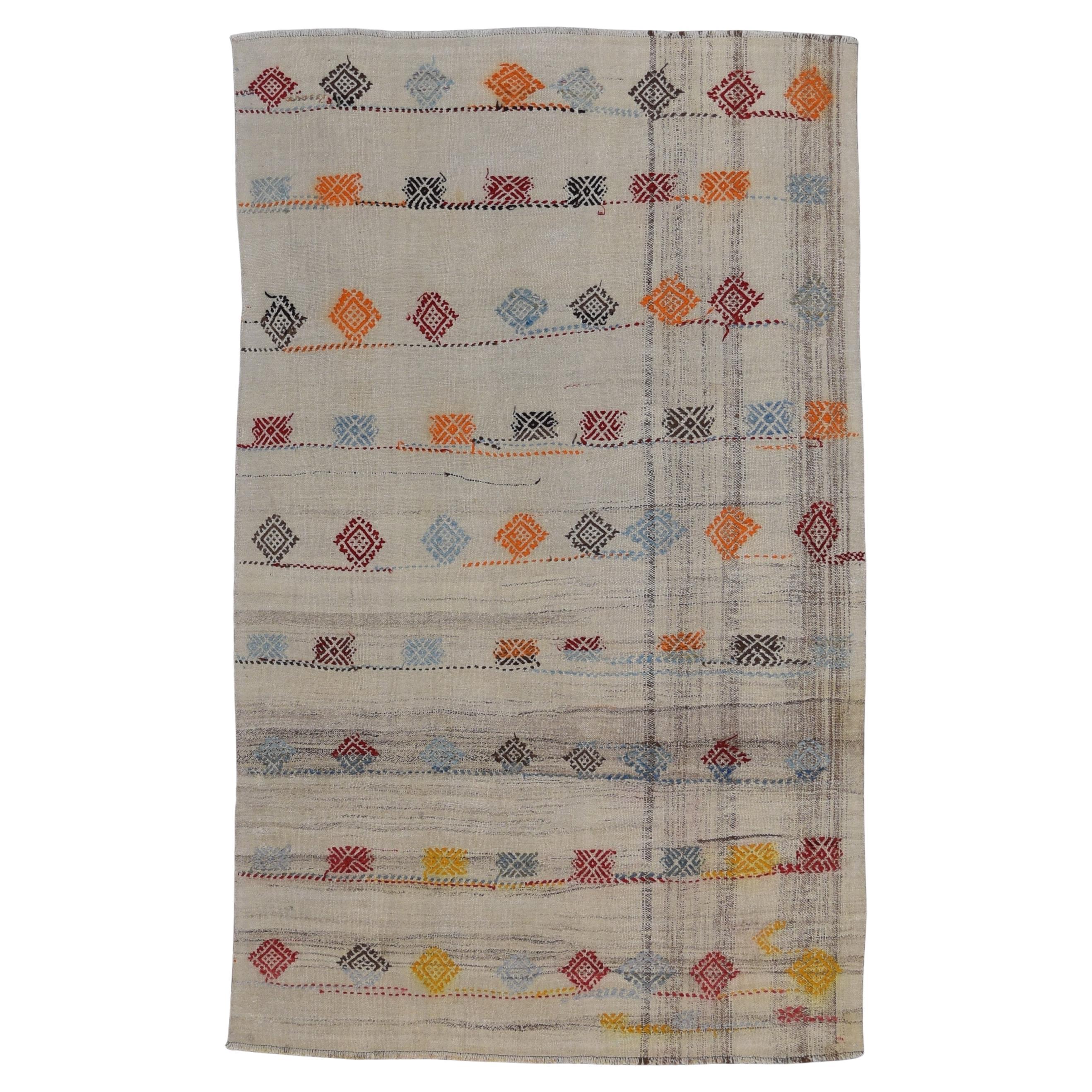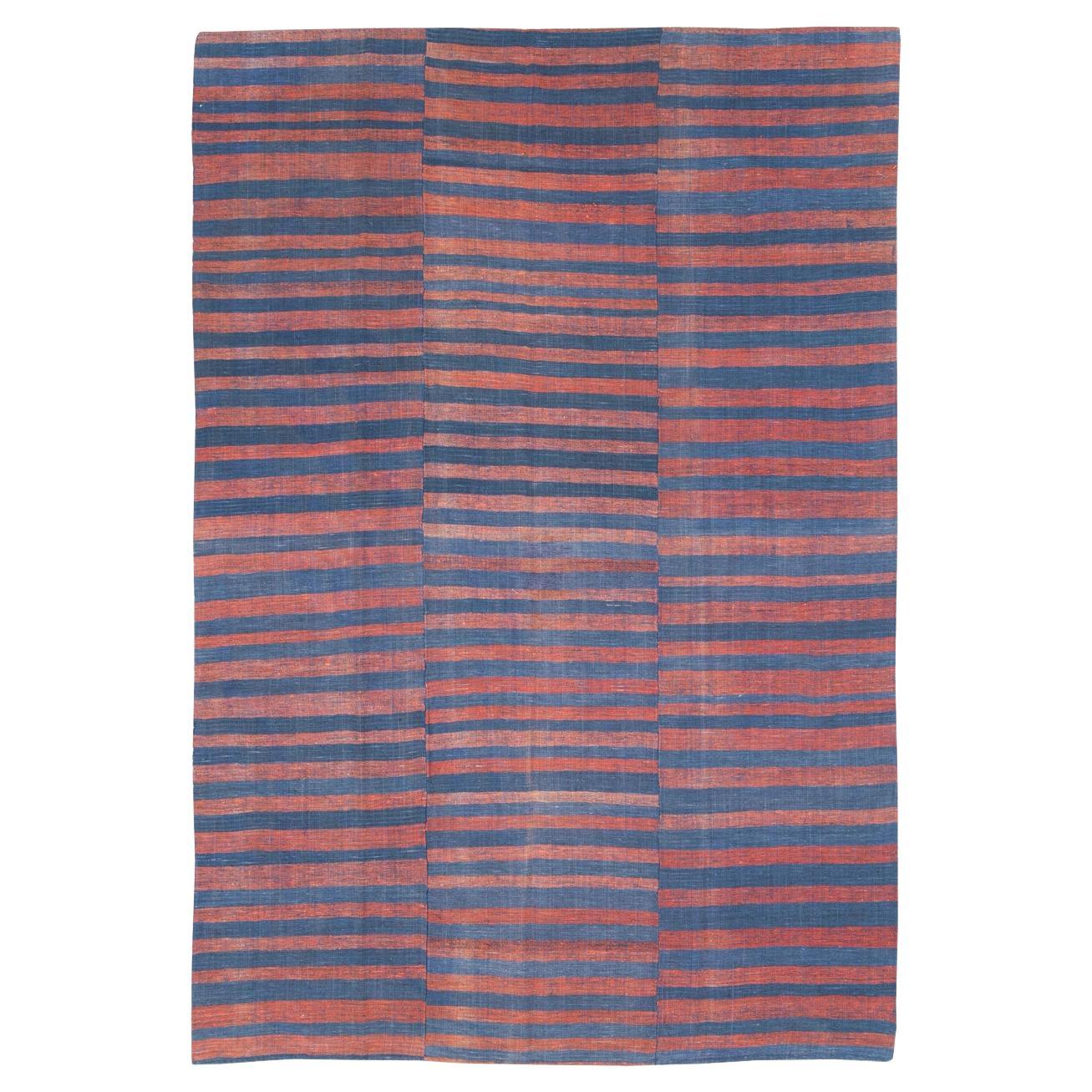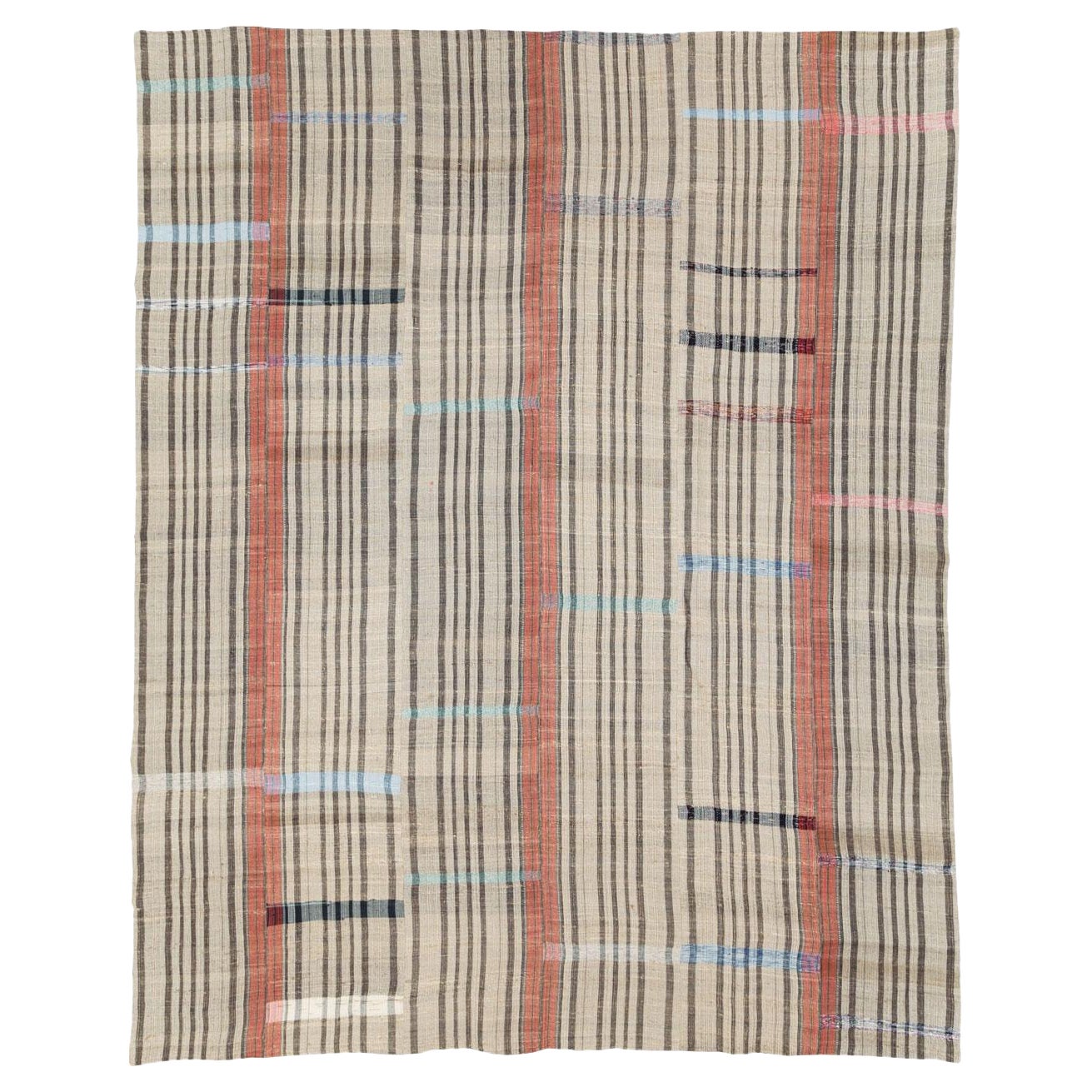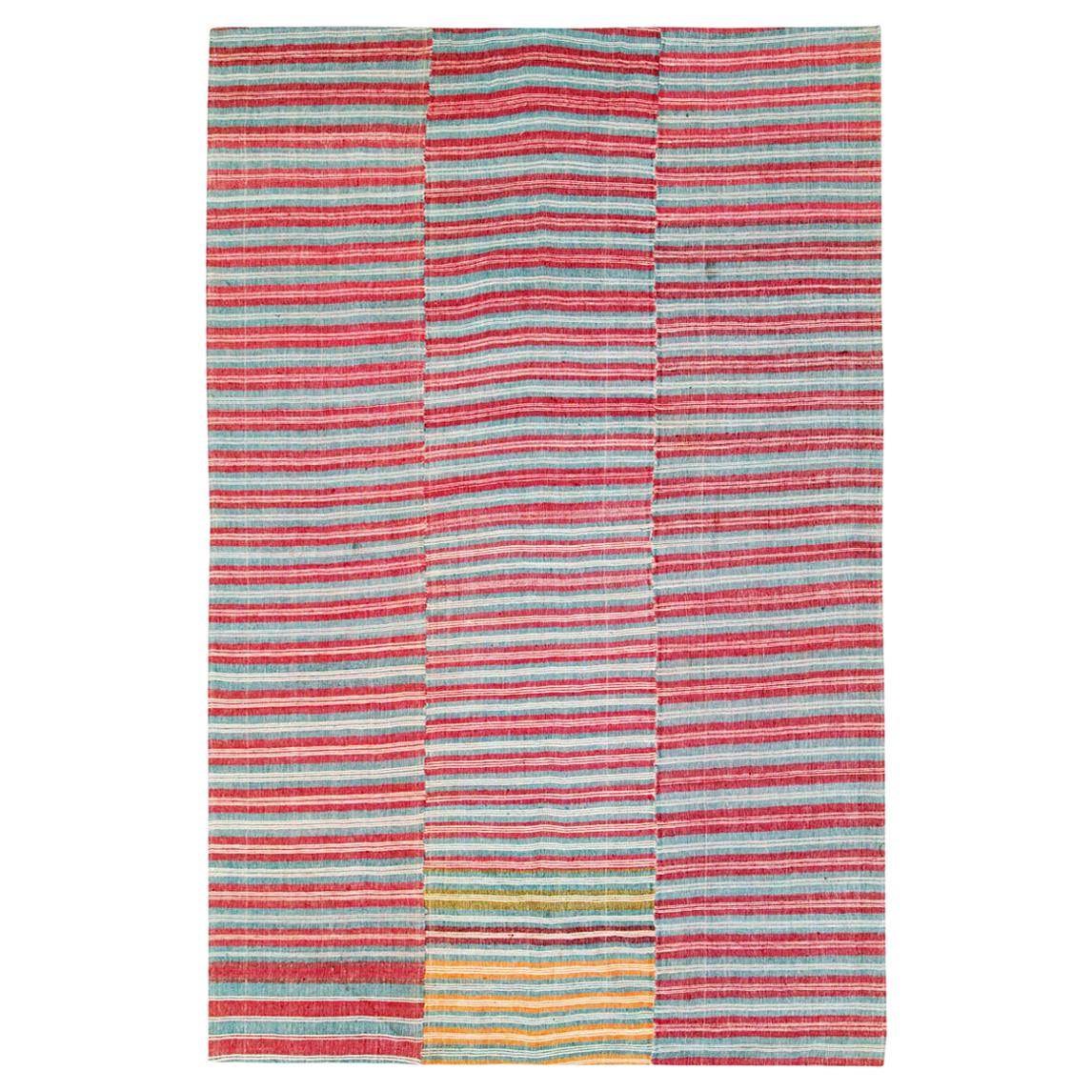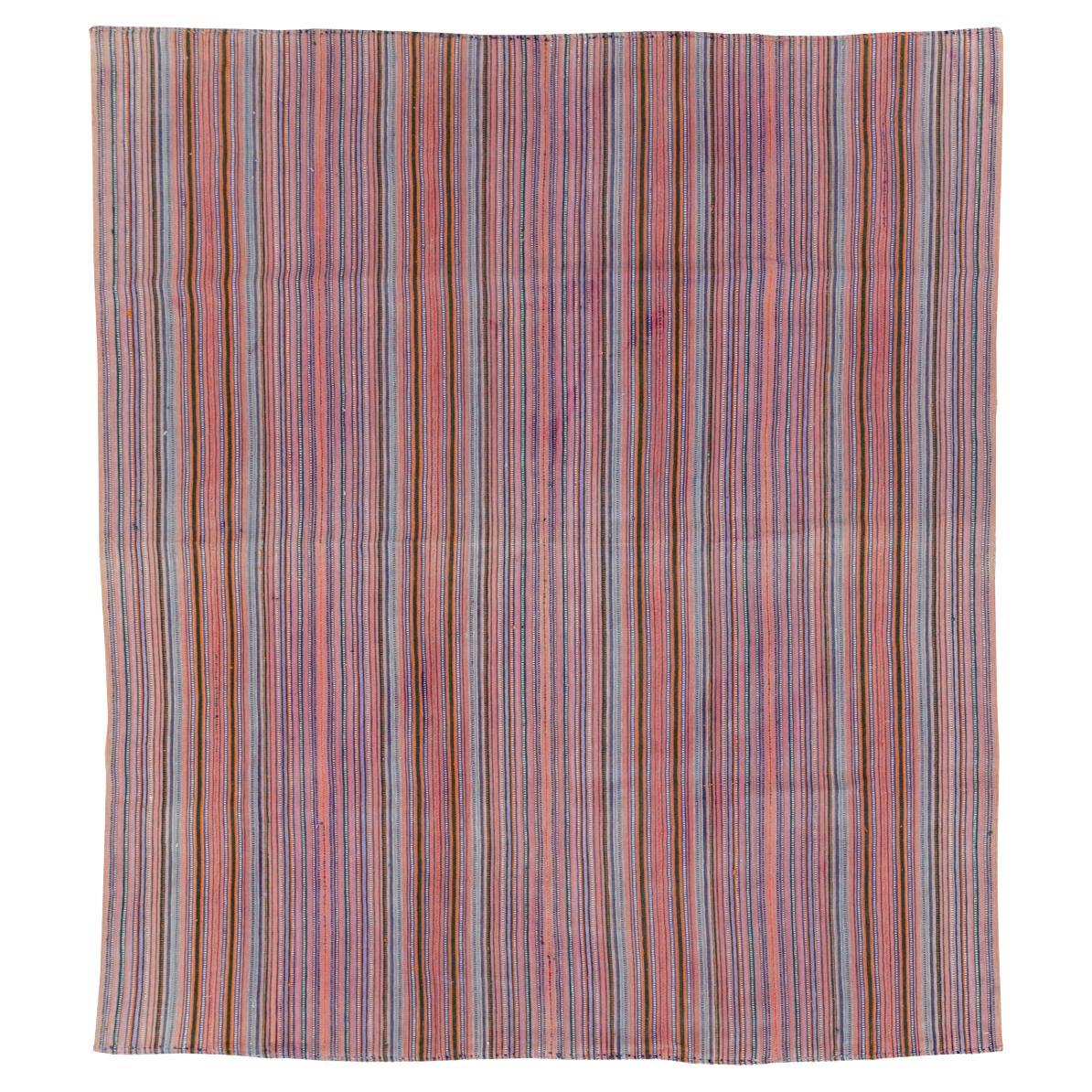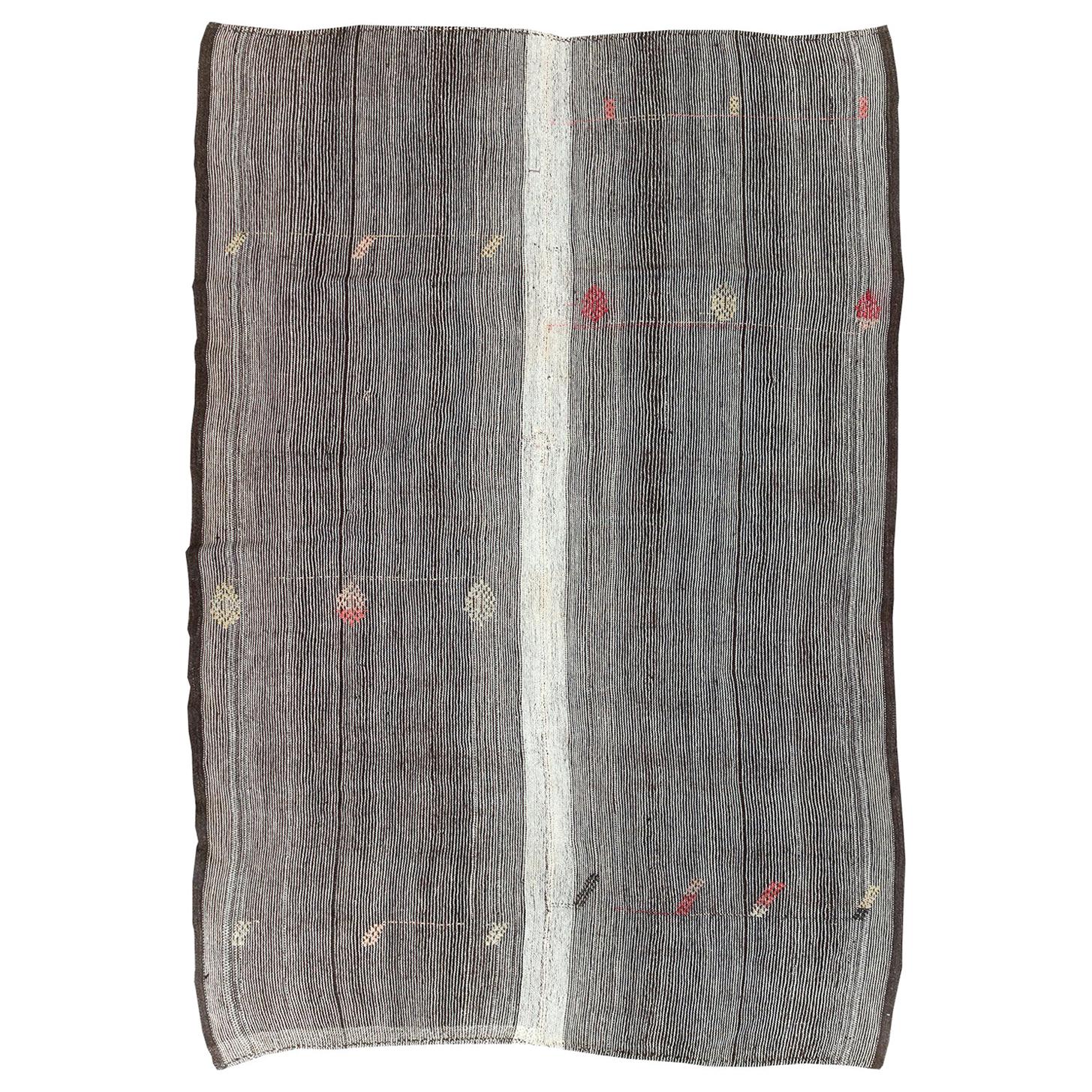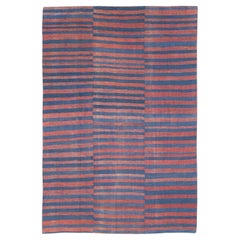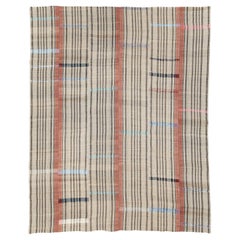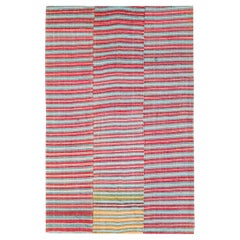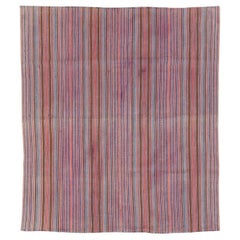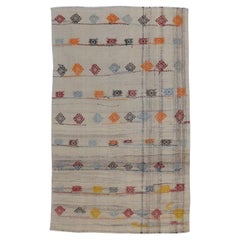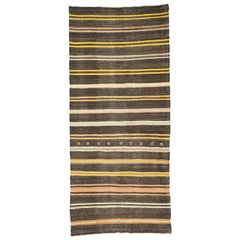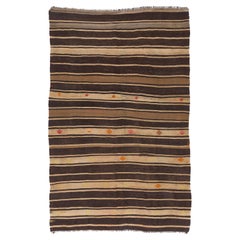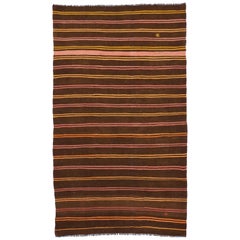Items Similar to Mid-20th Century Handmade Turkish Flat-Weave Kilim Accent Carpet
Want more images or videos?
Request additional images or videos from the seller
1 of 11
Mid-20th Century Handmade Turkish Flat-Weave Kilim Accent Carpet
$3,125
£2,347.59
€2,707.15
CA$4,336.35
A$4,818.64
CHF 2,525.02
MX$59,091.98
NOK 32,205.11
SEK 30,297.39
DKK 20,205.02
Shipping
Retrieving quote...The 1stDibs Promise:
Authenticity Guarantee,
Money-Back Guarantee,
24-Hour Cancellation
About the Item
A vintage Turkish flat-weave Kilim accent carpet handmade during the mid-20th century.
Measures: 6' 10" x 9' 7"
Flat-weave rugs & carpets:
Knotted pile rugs are just one small part of a vast universe of textile techniques suitable for heavy use. If you can imagine it, some weaver has tried it out. Pieces can be roughly divided into those reversible from the start and those never, or at least not initially, reversible. Thus, kilims are considered reversible, while everything else is not.
Kilims are tapestry woven rugs with both sides the same, in either slit technique where colors change, or with various methods of avoiding slits. Slit tapestry weave goes back to ancient times and Coptic Egyptian weavers used it for ornaments on garments and larger wall hangings. Slits can be avoided by dovetailing of colors (warp sharing) or by interlocking the wefts. The Navajo weavers of the Southwest practice the first while the Fine shawl weavers of Kashmir and Kerman employed the second. Interlocking produces a one-faced fabric, with smooth and rough, ridged faces. The typical Turkish, Caucasian, or Persian rustic Kilim shows slits, but never long ones. Aubusson French carpets are also slit tapestries and the long color transitions are sewn up as part of the regular maintenance. Some kilims are very Fine. The best antique urban Sehna (Senna) kilims on wool, cotton or silk warps approximate the comparable rugs in refinement and are the most desirable of all Persian kilims. Although the various flatweave techniques are usually expressed in geometric, simple, often repeating, patterns, Sehna kilims demonstrate that even the most intricate designs can be effectively rendered in flat-stich. The term ‘Kilim’ has been extended to cover any pileless, weft-faced heavy textile. Thus, the sectioned and joined northeastern Persian horizontally striped wool rugs are called ‘kilims’. So are the plain-weave end finishes of pile rugs. All these are weft-faced, weft patterned flatweaves.
These sectioned pieces are woven not on a frame loom, but one steadied by the weaver at one end and with the warps fastened down at the other. Only relatively recent have these tribal pieces become available. They are used as floorcoverings, hangings, room dividers, furniture covers. They are mostly bitonal in shades of natural dark brown and beige. Some more recent pieces show weaver innovations with ikat and moire effects. Work proceeds quickly and a skilled weaver can complete a thirty foot strip in almost no time.
Wefts, the elements added as weaving progresses, play an essential part in what is a flatweave. The best-known example of an extra-weft, wrapping technique is on Caucasian and tribal Persian Soumaks, where a pattern weft wraps around the fixed warp, changing as weaving progresses. Soumaks can be large carpets, Kuba in the Caucasus, small bag faces (Caucasian and Persian Shah Savan saddle bags), or cover scatter rugs (Persian Afshars). The Soumak technique is fast, and a weaver can work much more quickly than tying knots. The left-over wefts are cut off on the back, so the front and back are initially different. As a Soumak on the floor gets used, these weft yarns wear away and the two sides converge although the exact texture remains distinct.
There are other ways of pattern by weft. Often on smaller tribal pieces, the pattern weft(s) is (are) part of the weft structure, moving in an out, and holding the whole thing together. These wefts can be complementary or added (supplementary), continuous across the flatweave or cut off as they travel unneeded across the verso. Supplementary weft flatweaves are often very compact and substantial. The nomadic Turkmen and Balouch tribes employ both supplementary and complementary weft techniques on their pieces. Supplementary wefts are often raised on the recto (front) while complementary wefts are flat to the surface. Tribal Kurds employ this extra-wefting technique. The Balouch of Pakistan use complementary wefts almost exclusively on their small woven paraphernalia like salt bags.
Flatweave techniques may be combined on a single piece. Afshar rugs employ plain-weave end strips, preceded by Soumak bands, with pile sections between. The large Bakhtiari saddlebags feature Soumak work, pile “islands” an areas of plain-weave. Qashqai rugs and kilims frequently displays checkerboard end strips in continuous, complementary wefting.
Another distinct flatweave type is the jajim (jijim, cecim) in which a pattern is added with colored wefts as the weaving of the plain-weave ground progresses. Here the wefts are discontinuous and the pattern stands proud from the voided ground. Often made in two pieces on narrow looms and edge-sewn together, these may have geometric patterns. The term ‘jajim’ also refers to the assembled warp-faced strip and stripe covers from the Shah Savan of northwest Persia, the pattern is defined by warps alone, usually in plain stripes, but sometimes in designs of ladders, snakes, human figures and various animals. Here the color changing warps are continuous. Most are wool, a few are silk. Better to call these something else.
Indian ‘Dhurries’ are all cotton kilims and ‘shatrangis’ employ wool wefts on cotton warps. Dhurries are slitless. The cotton texture is more appropriate to the humid and warm climate of the Indian subcontinent. Modern Dhurries are horizontally striped or show repeating patterns of squares, but the very oldest are more curvilinear and even pictorial.
Sometimes the pattern is reversed, red for blue, blue for red. This double faced, usually heavy fabric is best in wool. Not a true double cloth, but a good tribal approximation. The wefts are continuous here
and the piece has double the life.
Flatweaves can also be created by embroidery. Pattern yarns are passed through a ground fabric with a needle or hook, not on a loom while in progress, but on finished sections of plain-weave affixed to a frame. The work can be divided among several artisans and the sections later joined. This technique was used in Britain and France, especially in large carpets with repeating squares patterns. Wool is the embroidery material of choice, the technique is needlepoint, and the ground is linen. Embroidery is used on very few Oriental rugs, but it does appear on the silk on linen or cotton Caucasian 17th-18th century pieces in floral, pictorial, or mihrab arch layouts. These are not really rugs and are not reversible.
There are combinations of flatweave techniques and knotted pile. The best known are the “soufs”, where a raise, relief pile stands above a brocaded ground. In the most luxurious examples, the ground is gilt silver or silver wrapped silk thread (metal thread) and the islands of pile are silk. This technique is found on certain Chinese rugs purporting by inscription to originate in the Forbidden City palaces and on certain Persian pieces including the early 17th century Isfahan “Polonaise” rugs.
Tapestry woven carpets with black grounds and rose bouquet repeating medallions come from Ukraine, southern Russia (Bessarabia), and Moldova. Large pieces are highly sought-after by designers.
If you can imagine a flatweave technique, a rug has probably been made with it.
About the Seller
5.0
Gold Seller
Premium sellers maintaining a 4.3+ rating and 24-hour response times
Established in 1989
1stDibs seller since 2009
595 sales on 1stDibs
Typical response time: 1 hour
- ShippingRetrieving quote...Shipping from: New York, NY
- Return Policy
Authenticity Guarantee
In the unlikely event there’s an issue with an item’s authenticity, contact us within 1 year for a full refund. DetailsMoney-Back Guarantee
If your item is not as described, is damaged in transit, or does not arrive, contact us within 7 days for a full refund. Details24-Hour Cancellation
You have a 24-hour grace period in which to reconsider your purchase, with no questions asked.Vetted Professional Sellers
Our world-class sellers must adhere to strict standards for service and quality, maintaining the integrity of our listings.Price-Match Guarantee
If you find that a seller listed the same item for a lower price elsewhere, we’ll match it.Trusted Global Delivery
Our best-in-class carrier network provides specialized shipping options worldwide, including custom delivery.More From This Seller
View AllMid-20th Century Turkish Flatweave Kilim Accent Rug
Located in New York, NY
This Mid-20th century Turkish Flatweave Kilim rug, measuring 6' 3" x 9' 0", features a bold and timeless striped design in a striking color palette of indigo blue and warm terracotta...
Category
Mid-20th Century Turkish Kilim Turkish Rugs
Materials
Wool
Mid-20th Century Handmade Turkish Flatweave Kilim Room Size Carpet
Located in New York, NY
A vintage Turkish flatweave Kilim room size carpet handmade during the mid-20th century.
Measures: 11' 0" x 14' 0".
Category
Mid-20th Century Turkish Rustic Turkish Rugs
Materials
Wool
Vintage Handmade Turkish Flat-Weave Kilim Accent Rug
Located in New York, NY
A vintage Turkish flat-weave Kilim accent rug handmade during the mid-20th century.
Measures: 6'6" x 9'10".
Category
Mid-20th Century Turkish Modern Turkish Rugs
Materials
Wool
Mid-20th Century Persian Flatweave Kilim Accent Rug
Located in New York, NY
This Mid-20th century Persian Flatweave Kilim rug, measuring 5' 5" x 6' 3", features a vibrant array of closely spaced vertical stripes in soft yet lively colors. The palette include...
Category
Mid-20th Century Persian Kilim Persian Rugs
Materials
Wool
Mid-20th Century Handmade Turkish Flatweave Kilim Accent Rug
Located in New York, NY
A vintage Turkish flatweave Kilim accent rug handmade during the mid-20th century.
Measures: 7' 2" x 10' 7".
Category
Mid-20th Century Turkish Modern Turkish Rugs
Materials
Wool
$1,500 Sale Price
20% Off
Mid-20th Century Turkish Flatweave Kilim Accent Rug
Located in New York, NY
This Mid-20th century Turkish Flatweave Kilim rug, measuring 5' 11" x 9' 2", presents a lively striped design that embodies the bold color combinations characteristic of traditional ...
Category
Mid-20th Century Turkish Kilim Turkish Rugs
Materials
Wool
You May Also Like
Vintage Turkish Tülü Wool Kilim 5'7''x9'2''
By Amara Rugs
Located in Torrance, CA
This unique handwoven wool kilim features a warm ivory ground adorned with vibrant tribal motifs arranged in a playful yet balanced composition. Rows of geometric diamond symbols—wov...
Category
Early 20th Century Turkish Kilim Turkish Rugs
Materials
Wool
Vintage Turkish Kilim Rug, Flat-Weave Kilim Rug
Located in Dallas, TX
51332, vintage Turkish Kilim rug. This handwoven wool vintage Turkish Kilim rug features a series of stripes in soft colors on a dark contrasting background. This flat-weave Kilim rug displays symbols of running water, burdock and a small hook. The symbols represent marriage (hook), abundance, protection (burdock) and the continuity of life (running water). Blending nomadic charm, ancient symbolism and Folk Art warmth, this vintage Turkish Kilim rug reflects generations of cultural beliefs and serves many design purposes. Perfect for extra-wide and long hallways, corridors, galley kitchens and Bohemian decor...
Category
Mid-20th Century Turkish Kilim Turkish Rugs
Materials
Wool
$1,199 Sale Price
20% Off
6.4x10 Ft Vintage Handmade Banded Turkish Kilim Rug Made of Natural Un-Dyed Wool
Located in Spring Valley, NY
A handwoven vintage banded central Anatolian kilim made entirely of un-dyed natural wool featuring earthy tones of light brown, dark brown and ivory. Dainty little brocades sparsely ...
Category
Vintage 1960s Turkish Kilim Turkish Rugs
Materials
Wool
$879 Sale Price
40% Off
Free Shipping
Vintage Turkish Kilim Rug with Tribal Style, Flat-Weave Rug
Located in Dallas, TX
51350, vintage Turkish Kilim rug with tribal style, flat-weave rug. This vintage Turkish Kilim rug features colorful stripes on a warm brown background. The tribal style and vibrant ...
Category
Mid-20th Century Turkish Kilim Turkish Rugs
Materials
Wool
$1,060 Sale Price
20% Off
Vintage Hand-Woven Flatweave Kilim in Wool with Sub-Geometric Design and Motifs
Located in Atlanta, GA
This flat-weave tribal kilim has been hand-woven in wool. The rug features a horizontal stripe design, accentuated by various sub-geometric motifs. The rug has been rendered in multi...
Category
Mid-20th Century Turkish Kilim Turkish Rugs
Materials
Wool
Turkish Kilim Area Size Flat Weave Rug
Located in New York, NY
A colorful Turkish Kilim flat-weave rug. Large-scale lime green medallion with accents in orange, pink, gray on a burnt red field with a striped motif on both ends.
Category
20th Century Turkish Kilim Turkish Rugs
Materials
Wool
More Ways To Browse
Vintage Carpet Bag
Mid Century Modern Metal Room Divider
18th Century Embroidery
Tapestries 17th And 18th Century
Vintage Wool Shawl
17th Century French Aubusson Tapestry
Animal Hooks
Indian Arch
French Ladder Back
Vintage Silk Bags
Arch Room Divider
Vintage Silk Brocade Fabric
Indian Silk Tapestry
Very Large French Tapestries
18th Century Needlepoint
18th Century Russian Silver
Vintage Chinese Silk Fabric
Chinese Shawls
